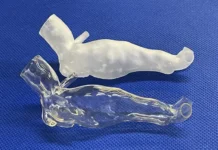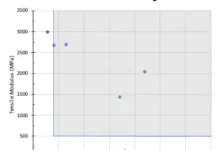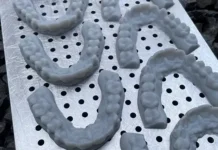By Heather Francis, chemist, and Ahmet Nebioglu, R&D manager, Dymax Corporation
Abstract
The present work addresses a strong market demand for oligomers for 3D printing formulations. Structure-property relationships in a new family of oligomers will be discussed. Effect of oligomers on oxygen inhibition, coefficient of thermal expansion, heat distortion temperature, shrinkage and color stability will be revealed. Some of the formulations based on the various new oligomers are very fast curing and prone to substantially less oxygen inhibition. They demonstrate good adhesion to different substrates and possess very low water absorption characteristics.
Introduction
3D printing uses additive manufacturing processes that implement gradual creation or addition of materials to form an object. 3D printing has become a widely used method for manufacturing prototypes in many industries, including automotive, aerospace, consumer goods, and medical device, since it produces prototypes with complex shapes relatively quickly and at a significantly lower cost than traditional methods.
A number of 3D printing methods exist, but the most common methods that use light to form the desired 3D shapes are stereolithography (SLA), UV inkjet and digital light processing (DLP).
- SLA – SLA uses a UV laser to crosslink a liquid resin in a specific area with a specific depth. Once the first layer of the desired object is formed, it is lowered, and the liquid resin is reapplied on top of it. Successive curing of layers forms the desired object with high precision.
- UV Inkjet – The 3D UV inkjet printing method works in a manner similar to that of a 2D UV inkjet printer. Instead of printing on paper, successive layers are printed and cured on top of the previous layer.
- DLP – DLP uses a digital light projector to project a 2D image and cure the resin. Successive curing of the 2D images form the 3D shape desired. Compared to the other methods, the light irradiance used in DLP is significantly lower.
Replacing traditional mass manufacturing processes with 3D printing is appealing from a commercial perspective, especially in applications where only a relatively small number of parts are required. Unfortunately, several challenges prevent the realization of this potential: speed of manufacture and meeting material performance properties are the most important ones. From a materials perspective, it has been a challenge to match the performance of common plastics, such as PC and ABS. It often is difficult to match deformation resistance of plastics at elevated temperatures with thermoset materials. In this study, we investigated oligomers used in the 3D printing industry and ways to improve their heat distortion temperatures without significantly diminishing other performance attributes.
Experimental

All oligomers were analyzed with gel permeation chromatography (Polymer Labs PL-GPC 50 equipped with RI detector and mixed D-columns) and FTIR spectroscopy (Perkin Elmer Spectrum 100). Viscosities were measured using a Brookfield CAP 2000+ viscometer. The oligomers were tested for potential use in 3D printing applications using a simple model formula (Table 1). Formulations were mixed using a FlackTek DAC 150.1 FVZ SpeedMixer at 3,000 rpm for 2.5 minutes. For ease of testing and comparison, formulations were cast in single-layer films when applicable. Such films could be viewed as corresponding to the individually cured layers of a fully 3D printed object.
Each formulation was cured with a Dymax UVCS Light-Curing Conveyor outfitted with 5000-EC flood lamps at an irradiance of 300 mW/cm2 and 4,000 mJ/cm2 energy. The curing irradiance and energy were recorded using an ACCU-CAL™ 150 radiometer.
The durometer hardness of each formulation was measured using ASTM D2240. Cure profiles of all formulations were analyzed by a differential scanning calorimeter (DSC) equipped with a Dymax BlueWave® 200 spot lamp. After 30 seconds of isothermal stabilization at 25°C, samples were exposed to 50 mW/cm2 UV irradiance for 15 seconds. Tensile properties were measured with an Instron system according to ASTM D882. Thermal Analysis DMA Q800 was used to measure the heat deflection temperature (ASTM D648) and the glass transition temperature (ASTM E1640).
Results and Discussion

In general, polyurethane acrylates are used in 3D printing formulations, primarily due to the toughness they provide. This toughness is critical in obtaining impact- and scratch-resistant objects. Three different types of polyurethane acrylates were synthesized to investigate how the structure of polyurethane acrylates affects the critical properties needed for 3D printing resins. Representative structures of these polyurethane acrylate (PUA) oligomers are given in Figure 1. The first type is the most common type of PUA. The backbone contains soft and hard segments, and acrylate groups are connected to the hard segment. In the second type, the acrylate group is directly connected to the soft segment. The third type of PUA has 3-acrylate functionality.

Table 2 shows the Type 1 oligomers’ structural description and viscosity of the model formula with the corresponding oligomer. Acrylate ratio is defined as the relative ratio of the acrylate groups within each oligomer. Soft segment ratio (SSR) and hard segment ratio (HSR) are relative length of the soft and hard segments of each oligomer, respectively, compared to other oligomers. According to Table 1, oligomers 1B, 1C and 1D have the same amount of HSR. With an increase in SSR, the viscosity of the formulations decreased.

Table 3 lists the physical properties of the cured formulations. Heat distortion temperature (HDT) is important for operating temperature of the printed objects, especially for non-prototype applications. Oligomers 1C and 1D showed the highest HDT. Both had high HSR and the highest acrylate amount (AR). Oligomer 1D had higher SSR, which resulted in a slightly higher elongation at break and a lower tensile modulus compared to 1C. It was interesting that the HDT of 1D was same as 1C, even though it had higher SSR. From 1B to 1C, AR and SSR were increased by about the same factor, and as a result the HDT increased (despite the increase in SSR). 1A provided very good elongation due to its high SSR. It can be used as an additive oligomer in objects that require relatively high elongation rates.

Table 4 shows the Type 2 oligomers’ structural description and viscosity of the model formula with the corresponding oligomer. Type 2 oligomers provided significantly lower viscosities compared to Type 1 oligomers. The viscosity of the formulation with oligomer 2C was exceptionally low.

Type 2 oligomers provided lower HDT compared to relatively similar SSR, HSR and AR containing Type 1 oligomers. This might be related to hard segments proximity to acrylate groups and the hard segments proximity to crosslinks in the cured material. When the hard segments are closer to crosslinks, it might be more difficult to distort the crosslinks and, therefore, result in higher HDT. Type 2 oligomers also provided higher tensile strength and lower linear shrinkage values compared to Type 1 oligomers (Table 5). Lower shrinkage might be due to relatively less stress formation during curing due to hard segments proximity to the crosslinking site. Less stress buildup in the material also affects tensile properties. An increase of HSR and AR, along with a decrease in SSR, appears to increase HDT. Oligomer 2A is appealing due to very low shrinkage and good balance of tensile strength and elongation.

Oligomers with Type 3 (Tables 6 and 7) structure have an average of three acrylate functionalities per polymer chain. It does not appear that increasing functionality of an oligomer simply improves HDT. When

compared to 1B, 3A has the same HSR and also has relatively higher SSR and lower AR which, as expected, result in lower HDT than 1B. Higher functionality of 3A did not improve HDT. Oligomers 3B and 3C have significantly higher HSR and lower SSR than 3A, which resulted in higher HDT. It is interesting to note that 3A has practically the same Tg as 3B and 3C, but significantly lower HDT. This is most likely due to higher amounts of trapped soft segments that are relatively easier to deform at elevated temperatures.

The cure speed of a formulation is an important factor in many 3D printing applications. Relative cure speeds of the formulations were measured by photo-DSC, based on time to reach gel point, and are recounted in Table 8. Formulations with Type 2 oligomers cured relatively slowly. Type 1 oligomers cured relatively fast, except very high SSR ratio oligomer (1A). Among Type 3 oligomers, 3B cured fastest, possibly due to a lower SSR ratio.
Conclusion
In this paper, we have described several new polyurethane acrylate oligomers of differing structure that might find uses in a wide range of 3D printing applications. These oligomers’ physical properties have been compared in a model formula, and various structure-property relations have been explored. Several oligomers exhibited high heat-distortion temperatures and fast cure speeds. Such oligomers could be useful in applications that require the material properties to more closely resemble common plastics such as PC or ABS. Still other oligomers may have value in different 3D printing applications requiring a material with a balance of hardness, toughness and flexibility. Understanding the relationship between the structure of these oligomers and their ultimate properties can lead the way to tailor-made products for each 3D printing application.
Heather Francis is a chemist at Dymax Oligomers and Coatings. She holds a bachelors of science degree in Biology from Bay Path University. Dr. Ahmet Nebioglu is the R&D manager of Dymax Oligomers and Coatings. He holds a bachelor’s science degrees in both chemical engineering and chemistry from Bogaziçi University and a doctorate degree in polymer engineering from the University of Akron.
Dymax Corporation develops innovative oligomer, adhesive, coating, dispensing and light-curing systems for applications in a wide range of markets. The companys products are perfectly matched to work seamlessly with each other, providing design engineers with tools to dramatically improve manufacturing efficiency and reduce costs. Major markets include aerospace, appliance, automotive, electronics, industrial, medical device and metal finishing. For more information, visit www.dymax.com.






